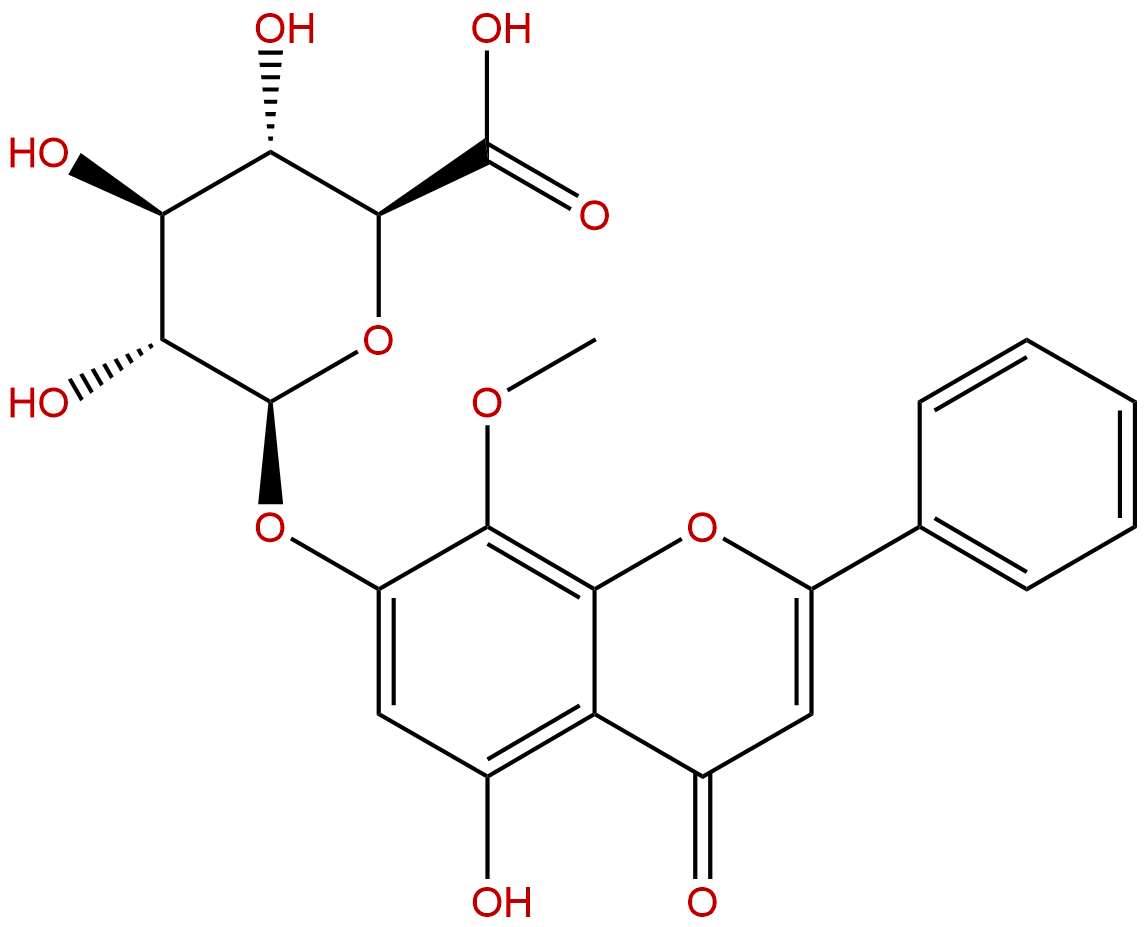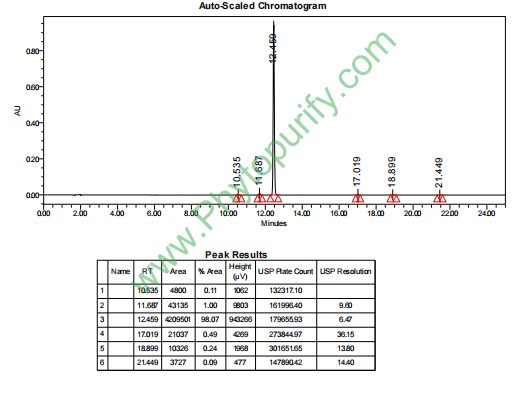
WogonosideCAS No.:51059-44-0
|
||||||||||
 |
|
|
||||||||

| Catalogue No.: | BP1454 |
| Formula: | C22H20O11 |
| Mol Weight: | 460.391 |
Product name: Wogonoside
Synonym name: Oroxindin; Glychionide B
Catalogue No.: BP1454
Cas No.: 51059-44-0
Formula: C22H20O11
Mol Weight: 460.391
Botanical Source: Scutellariae radix
Physical Description:
Type of Compound: Flavonoids
Purity: 95%~99%
Analysis Method: HPLC-DAD or/and HPLC-ELSD
Identification Method: Mass, NMR
Packing: Brown vial or HDPE plastic bottle
Storage: Store in a well closed container, protected from air and light. Put into refrigerate or freeze for long term storage.
Whenever possible, you should prepare and use solutions on the same day. However, if you need to make up stock solutions in advance, we recommend that you store the solution as aliquots in tightly sealed vials at -20℃. Generally, these will be useable for up to two weeks.
The product could be supplied from milligrams to grams
Inquire for bulk scale.
Description:
Wogonoside has anticoagulant, anti-inflammatory, anti-angiogenic and anticancer effects, it may exert its anti-inflammatory effect via dual inhibition of NF-κB and NLRP3 inflammasome. Wogonoside induced autophagy through the MAPK-mTOR pathway, it inhibited LTB 4 production at the concentration of 100 uM.
References:
Toxicology. 2009 May 2;259(1-2):10-7.
Wogonoside inhibits lipopolysaccharide-induced angiogenesis in vitro and in vivo via toll-like receptor 4 signal transduction.
Wogonoside, one flavonoid derived from the root of Scutellaria baicalensis Georgi, has been reported for its anti-inflammation activity; however, whether it can inhibit inflammation-induced angiogenesis is still unclear.
METHODS AND RESULTS:
In the present study, we evaluated the effect of Wogonoside on lipopolysaccharide (LPS)-induced angiogenesis in vitro and in vivo. Wogonoside suppressed the LPS-stimulated migration and tube formation of human umbilical vein endothelial cells (HUVECs), as well as microvessel sprouting from rat aortic rings in vitro. Moreover, Wogonoside also inhibited LPS-stimulated vessel growth of Chicken chorioallantoic membrane (CAM) in vivo. The mechanism revealed that Wogonoside inhibited LPS-induced toll-like receptor 4 (TLR4) up-regulation and its downstream mitogen-activated protein kinases (MAPKs) activation, by decreasing the phosphorylation of c-Jun N-terminal kinase (JNK), extracellular signal-regulated kinase (ERK) and p38 mitogen-activated protein kinase.
CONCLUSIONS:
The results suggest that Wogonoside inhibits LPS-induced angiogenesis both in vitro and in vivo, and that it might have a therapeutic potential for the diseases associated with the development of both inflammation and angiogenesis progress.
Food Chem Toxicol. 2013 Jan;51:53-60.
Wogonoside induces autophagy in MDA-MB-231 cells by regulating MAPK-mTOR pathway.
Previous studies have demonstrated that Wogonoside, a bioactive flavonoid extracted from the root of Scutellaria baicalensis Gerogi, has anti-inflammatory and anti-angiogenic activities.
METHODS AND RESULTS:
In this study, we evaluated Wogonoside-induced autophagy on human breast MDA-MB-231 cells. We report that Wogonoside triggered the formation of microtubule-associated protein-light chain 3 (MAP-LC3) positive autophagosomes and the accumulation of acidic vesicular and autolysosomes in MDA-MB-231 cells. In addition, cells treated by Wogonoside developed autophagosome-like characteristics, including single and double membrane vacuoles containing intact and degraded cellular debris. The results showed that Wogonoside promotes the expression of LC3-II and Beclin-1. Furthermore, Wogonoside inhibited cell growth of MDA-MB-231 cells in a concentration- and time-dependent manner, which was associated with Wogonoside-induced autophagy. Wogonosidealso suppressed the activation of mammalian target of rapamycin (mTOR) and p70-S6 kinase (p70S6K) by regulating the expression of the extracellular signal-regulated kinase (ERK1/2) and p38 involved mitogen-activated protein kinase (MAPK) signaling pathway.
CONCLUSIONS:
Taken together, these results suggest that Wogonoside partially inhibits MDA-MB-231 cell growth by inducing autophagy through the MAPK-mTOR pathway and may be a promising anti-tumor agent.
Biochem Pharmacol. 2015 Mar 15;94(2):142-54.
Wogonoside protects against dextran sulfate sodium-induced experimental colitis in mice by inhibiting NF-κB and NLRP3 inflammasome activation.
Previous studies have demonstrated that Wogonoside, the glucuronide metabolite of wogonin, has anti-inflammatory, anti-angiogenic and anticancer effects. However, the anti-inflammatory mechanism of Wogonoside has not been fully elucidated. Recently, NLRP3 inflammasome has been reported to be correlated with inflammatory bowel disease for its ability to induce IL-1β release. Nevertheless, there are few drug candidates targeting NLRP3 inflammasome for this disease.
METHODS AND RESULTS:
In this study, we investigated the anti-inflammatory effect of Wogonoside in dextran sulfate sodium (DSS)-induced murine colitis and further revealed the underlying mechanisms by targeting NF-κB and NLRP3 inflammasome. Wogonoside treatment dose-dependently attenuated DSS-induced body weight loss and colon length shortening. Moreover, Wogonoside prevented DSS-induced colonic pathological damage, remarkably inhibited inflammatory cells infiltration and significantly decreased myeloperoxidase (MPO) and inducible nitric oxide synthase (iNOS) activities. The production of pro-inflammatory mediators in serum and colon was also significantly reduced by Wogonoside. The underlying mechanisms for the protective effect of Wogonoside in DSS-induced colitis may be attributed to its inhibition on NF-κB and NLRP3 inflammasome activation in colons. Furthermore, Wogonoside markedly decreased production of IL-1β, TNF-α and IL-6 and suppressed mRNA expression of pro-IL-1β and NLRP3 in phorbol myristate acetate (PMA)-differentiated monocytic THP-1 cells via inhibiting the activation of NF-κB and NLRP3 inflammasome.
CONCLUSIONS:
In conclusion, our study demonstrated that Wogonoside may exert its anti-inflammatory effect via dual inhibition of NF-κB and NLRP3 inflammasome, suggesting that Wogonoside might be a potential effective drug for inflammatory bowel diseases.
HPLC of Wogonoside
